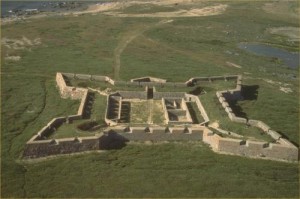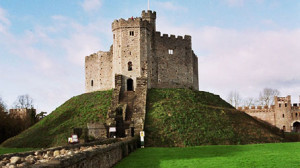Star Shaped Forts – Adventages And History
Star shaped forts or trace italiennes are a type of fortification that remained popular from the mid-15th century right up until the end of the 19th and they evolved for two main reasons.
First, they aimed to counteract the game-changing effects of gunpowder during sieges, with traditional square and ring-shaped forts now easily breached by cannon fire.
Second, star forts also mitigated a key defensive weakness traditional forts had become increasingly vulnerable to – ‘sapping’, or mining under the walls, by foes out of the firing line.
Star forts countered – to a degree-the effects of cannon fire by removing most perpendicular targets for the attacking force.
The design was chosen as cannon balls made short work of square-on fortifications largely due to their extensive surface area and lack of absorptive support when a shot made contact. This was because medieval castle and fort walls, which accounted for a large proportion of existing strongholds, had been designed to be relatively thin but high, making it hard for enemies to scale them and difficult for siege engines to fire over.
The advent of cannon fire, however, allowed these walls to be hit directly and with a ferocity that would easily demolish the stone and clay.
As such, this new form of fortification was built out of a series of interlocking and/or separate triangular bastions, which encircled the central town or keep within.
 The bastions were much thicker than standard walls and much flatter too, meaning that any cannon shot hitting them straight on would have its kinetic energy spread out and absorbed by successive layers of masonry. Further, any shot that was not a direct hit, or completely perpendicular, would glance off with little damaging effect.
The bastions were much thicker than standard walls and much flatter too, meaning that any cannon shot hitting them straight on would have its kinetic energy spread out and absorbed by successive layers of masonry. Further, any shot that was not a direct hit, or completely perpendicular, would glance off with little damaging effect.
The second reason why the star-shaped fort became widely adopted was that while it limited effective angles of attack for the offensive enemy force, it maximized those of the defensive one. This was due, simply, to the geometry of their bastions.
By creating a series of triangular spits that could be manned by gunners, attacking forces could be engaged over a far greater angle – over 180 degrees – and, more importantly, those forces that did reach the walls, could be continuously fired on from the side and rear.
These advantages were generally not granted by existing strongholds, as their flat-on walls meant infantry could only fire in a small arc in one direction – ie perpendicular to the wall. If forces did manage to reach the base, they could not be effectively engaged either as shooting straight down is very awkward.
Despite originating in the mid-15th century in Italy, by the 18th century star forts were a common sight in France, Germany, Croatia, Hungary and many other western nations (later spreading as far east as Japan). Many are acclaimed in historical record as key turning points in major battles. Indeed, the reign of the star fort only came to an end with the arrival of explosive shells towards the latter end of the 19th century.
Brod Fortress
Brod Fortress in Croatia is a sample of baroque star-shaped fort, located on the river Sava, and also a monument of zero categories and sights of Slavonski Brod town that makes its core.
With its stretches, this baroque structure is the largest building of its kind in Croatia, and among the largest in Europe. The fortress was fully prepared to defend 4,000 soldiers, while the reserves of water and living aided the maintenance and the thirty-day siege. On the ramparts and bastions there were 150 guns.
The square fortress (initial shape) with the hornwerk towards the river Sava and the ravelin on the other three sides was built in 1715 according to Will and Perette’s projects, and on a direct command of Prince Eugene Savoy in preparation for a war with Turkey (1716-1717).
The second phase of construction of the Fortress is marked by series of interventions from 1726 to 1731. By adding the outer ring, made up of alternating lines and contradictions, fortress is transformed into a star-shaped fortress of unique traits in the history of fortification architecture of the 18th century.
Citadel of Salah Ed-Din (Saladin)
The Citadel of Salah Ed-Din or Saladin, also know as Sahyun or Saladin Castle is a fort in Syria, 30 km east of Latakia town, built on a rock between two forest valleys.
Since 2006, along with the fortress of Krak des Chevaliers, it is on UNESCO’s list of world heritage sites in Asia and Oceania as “the most important example of the exchange of influence and evolution of fortification architecture in the Middle East during the Byzantine, Crusader and Islamic Periods.”
The fort at this place existed even in the first millennium BC, during the Phoenicians, who had surrendered to Alexander the Great 334 BC. According to the story, Alexander, after the unsuccessful siege of the fortress, dreamed of Hercules, who showed him weakest part of walls.
At the beginning of the 12th century, the crusaders conquered it, and it was already mentioned in 1119 as the property of Robert Saons. Today’s form of fort was mostly formed at that time, and was known as the only one that was not governed by knights.
In July 1188, the fort was conquered by Muslim warlord Saladin, after whom was later named.
Most famous feature of the fort is a 28 meters deep ditch, most likely carved into solid rock by Byzantine. It is 156 meters long, 14 to 20 meters wide, and has only one very narrow column in the middle, which served as a support for a moving bridge.
Top 3 fortifications
 1. Old – Motte-and-bailey castles
1. Old – Motte-and-bailey castles
The motte-and-bailey was a castle built on top of a natural or man-made mound. The walls and keep were usually made of stone.
2. Older – Hill fort
One of the earliest defensive man-made structures, hill forts were large earthworks consisting of a series of earthen walls and ditches built around a small settlement.
3. Oldest – Citadel
A citadel was a structure attached to a large town or city, either within its outer walls or part of them. Citadels provided a base for the city’s soldiers.












